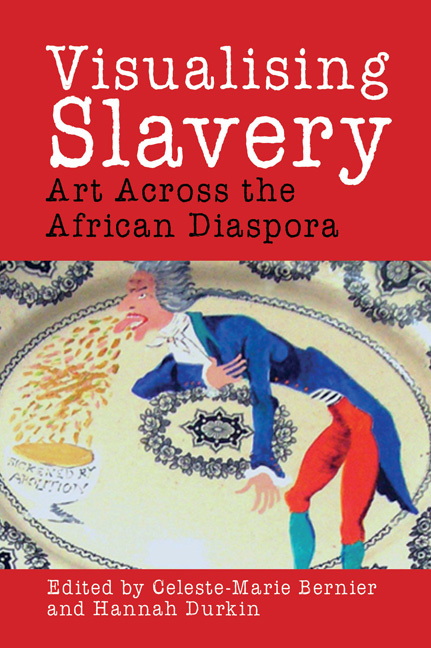Book contents
- Frontmatter
- Dedication
- Contents
- List of Illustrations
- Acknowledgements
- Introduction: ‘Inside the Invisible’: African Diasporic Artists Visualise Transatlantic Slavery
- Part I Slavery and Memory in Contemporary African Diasporic Art
- Part II Historical Iconography and Visualising Transatlantic Slavery
- Chapter 6 The Chattel Record: Visualising the Archive in Diasporan Art
- Chapter 7 Henry Box Brown, African Atlantic Artists and Radical Interventions
- Chapter 8 Uncle Tom and the Problem of ‘Soft’ Resistance to Slavery
- Chapter 9 The After-Image: Frederick Douglass in Visual Culture
- Part III African Diasporic Monuments and Memorialisation
- Part IV Contemporary Legacies in African Diasporic Art
- Afterword: Against the Grain: Contingency and Found Objects
- Notes on Contributors
- Index
- Platesection
Chapter 8 - Uncle Tom and the Problem of ‘Soft’ Resistance to Slavery
from Part II - Historical Iconography and Visualising Transatlantic Slavery
- Frontmatter
- Dedication
- Contents
- List of Illustrations
- Acknowledgements
- Introduction: ‘Inside the Invisible’: African Diasporic Artists Visualise Transatlantic Slavery
- Part I Slavery and Memory in Contemporary African Diasporic Art
- Part II Historical Iconography and Visualising Transatlantic Slavery
- Chapter 6 The Chattel Record: Visualising the Archive in Diasporan Art
- Chapter 7 Henry Box Brown, African Atlantic Artists and Radical Interventions
- Chapter 8 Uncle Tom and the Problem of ‘Soft’ Resistance to Slavery
- Chapter 9 The After-Image: Frederick Douglass in Visual Culture
- Part III African Diasporic Monuments and Memorialisation
- Part IV Contemporary Legacies in African Diasporic Art
- Afterword: Against the Grain: Contingency and Found Objects
- Notes on Contributors
- Index
- Platesection
Summary
Henry Louis Gates, Jr. has recently reminded us that the film Django Unchained (2012) revives the old and familiar trope of the difference between ‘The House Negro and the Field Negro’, as given currency in Malcolm X's famous speech to the Student Nonviolent Coordinating Committee workers in Selma, Alabama on 4 February 1965. In this speech, Malcolm X stated that:
Back during slavery, there were two kinds of slaves. There was the house Negro and the field Negro. The house Negroes – they lived in the house with master, they dressed pretty good, they ate good 'cause they ate his food – what he left. They lived in the attic or the basement, but still they lived near the master; and they loved their master more than the master loved himself. They would give their life to save the master's house quicker than the master would.
By contrast, Malcolm continued, there was the Field Negro, who ‘hated his master’:
When the house caught on fire, he didn't try to put it out; that field Negro prayed for a wind, for a breeze. When the master got sick, the field Negro prayed that he'd die. And how did the field Negro feel about running away or staging a rebellion? If someone come [sic] to the field Negro and said, ‘Let's separate, let's run’, he didn't say, ‘Where we going?’ He'd say, ‘Any place is better than here’. You've got field Negroes in America today. I'm a field Negro. The masses are the field Negroes … Just as the slave master of that day used Tom, the house Negro, to keep the field Negroes in check, the same old slave master today has Negroes who are nothing but modern Uncle Toms, 20th-century Uncle Toms, to keep you and me in check, keep us under control, keep us passive and peaceful and nonviolent. That's Tom making you nonviolent.
Malcolm X's target was of course Martin Luther King Jr., whose advocacy of non-violent resistance offered a widely accepted alternative to armed uprising, but it also gives currency to the use of Uncle Tom as the paradigm of the mild, biddable slave who selflessly identifies with his master's interests to the point of selling out his brothers in the fields, like the evil figure of Stephen played so compellingly by Samuel L. Jackson in Django Unchained.
- Type
- Chapter
- Information
- Visualising SlaveryArt Across the African Diaspora, pp. 119 - 128Publisher: Liverpool University PressPrint publication year: 2016



